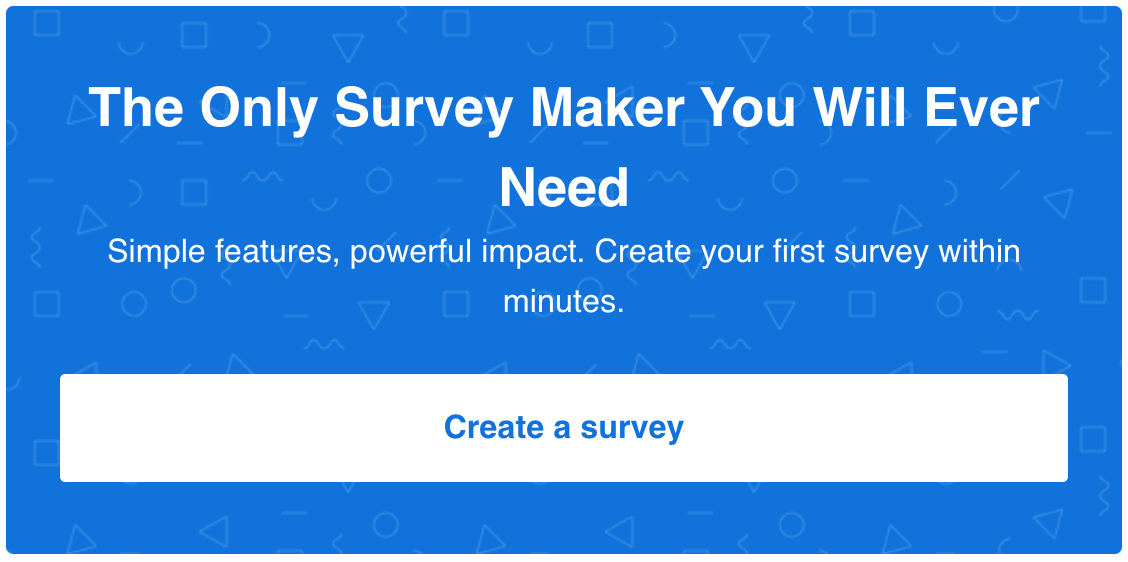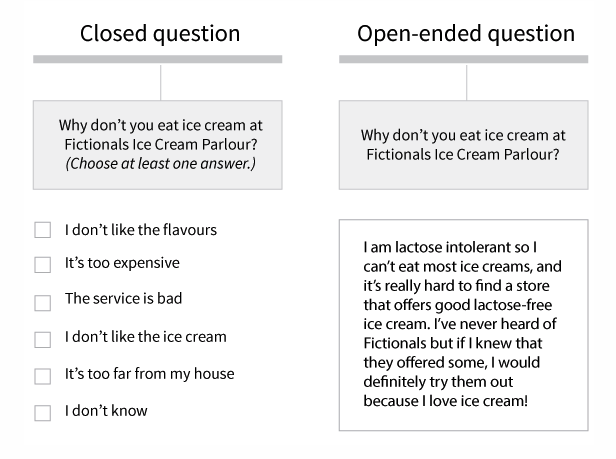Is Draw Bias Open Or Closed Face
v Data Collection Methods for Obtaining Quantitative and Qualitative Data
In the historic period when information is power, how we gather that information should be one of our major concerns, right? Also, which of the many data collection methods is the best for your item needs?

Whatever the answer to the two questions above, one thing is for sure – whether you're an enterprise, arrangement, agency, entrepreneur, researcher, student, or just a curious individual, data gathering needs to be ane of your top priorities.
Gratuitous Templates: xi Quiz and Survey Information Collection Templates
Still, raw data doesn't always take to exist particularly useful. Without proper context and structure, it's just a fix of random facts and figures after all. Yet, if yous organize, structure, and clarify information obtained from unlike sources, you've got yourself a powerful "fuel" for your decision-making.
So, why practice we collect data?
Why Collect Information
Information collection is defined as the "process of gathering and measuring data on variables of interest, in an established systematic fashion that enables one to answer queries, stated research questions, test hypotheses, and evaluate outcomes."
It is estimated that, by 2024, the total volume of data created and consumed worldwide volition attain 149 zettabytes. That beingness said, there are numerous reasons for data drove, but here we are going to focus primarily on those relevant to marketers and small business owners:
- Information technology helps y'all learn more than virtually your target audience by collecting demographic information
- It enables you to notice trends in the mode people change their opinions and behavior over time or in unlike circumstances
- It lets you segment your audition into different customer groups and direct different marketing strategies at each of the groups based on their private needs
- It facilitates decision making and improves the quality of decisions made
- Information technology helps resolve issues and improve the quality of your product or service based on the feedback obtained
Before we dive deeper into dissimilar data collection techniques and methods, let'south simply briefly differentiate between the two main types of data drove – primary and secondary.
Principal vs. Secondary Data Collection
Master information collection
Primary data (also referred to every bit raw data) is the information you collect first-hand directly from the source. In this case, you are the kickoff person to interact with and draw conclusions from such data, which makes it more difficult to interpret it.
According to CIO, eighty-ninety% of data generated today is unstructured . In other words, it's been collected as primary data only nothing meaningful has been done with it. Unstructured data needs to be organized and analyzed if it'due south going to be used as fuel for conclusion-making.
Secondary data collection
Secondary data represents information that has already been collected, structured, and analyzed by another researcher. If you are using books, enquiry papers, statistics, survey results that were created past someone else, they are considered to be secondary data.
Secondary data drove is much easier and faster than master. But, on the other paw, it's often very difficult to find secondary data that's 100% applicable to your ain situation, unlike main information collection, which is in most cases done with a specific need in mind.
Some examples of secondary data include census data gathered by the US Demography Bureau , stock prices information published by Nasdaq, employment and salaries data posted on Glassdoor, all kinds of statistics on Statista, etc.
Further along the line, both primary and secondary data can be broken downward into subcategories based on whether the data is qualitative or quantitative.
Quantitative vs. Qualitative information
Quantitative Information
This type of data deals with things that are measurable and can exist expressed in numbers or figures, or using other values that express quantity. That being said, quantitative data is usually expressed in numerical form and tin represent size, length, elapsing, amount, toll, and then on.
Quantitative research is most likely to provide answers to questions such equally who? when? where? what? and how many?
Quantitative survey questions are in nearly cases closed-concluded and created in accordance with the enquiry goals, thus making the answers easily transformable into numbers, charts, graphs, and tables.

The data obtained via quantitative data collection methods can be used to acquit market place research, test existing ideas or predictions, learn almost your customers, mensurate full general trends, and make important decisions.
For instance, you tin can employ information technology to measure the success of your product and which aspects may need improvement, the level of satisfaction of your customers, to find out whether and why your competitors are outselling you, or any other type of research.
As quantitative data drove methods are often based on mathematical calculations, the data obtained that way is normally seen as more than objective and reliable than qualitative. Some of the most mutual quantitative data collection techniques include surveys and questionnaires (with airtight-ended questions).
Compared to qualitative techniques, quantitative methods are commonly cheaper and information technology takes less time to gather data this way. Plus, due to a pretty high level of standardization, it's much easier to compare and analyze the findings obtained using quantitative data collection methods.
Qualitative Information
Dissimilar quantitative data, which deals with numbers and figures, qualitative data is descriptive in nature rather than numerical. Qualitative data is unremarkably not hands measurable as quantitative and tin can be gained through observation or open up-ended survey or interview questions.
Qualitative inquiry is most likely to provide answers to questions such as "why?" and "how?"
How?
Every bit mentioned, qualitative information drove methods are near probable to consist of open-concluded questions and descriptive answers and little or no numerical value. Qualitative data is an splendid way to gain insight into your audience's thoughts and beliefs (mayhap the ones you lot identified using quantitative research, but weren't able to clarify in greater detail).

Data obtained using qualitative information collection methods tin can be used to find new ideas, opportunities, and problems, test their value and accuracy, codify predictions, explore a certain field in more item, and explicate the numbers obtained using quantitative data drove techniques.
As quantitative data collection methods normally exercise not involve numbers and mathematical calculations but are rather concerned with words, sounds, thoughts, feelings, and other not-quantifiable information, qualitative data is often seen as more subjective, only at the same fourth dimension, it allows a greater depth of understanding.
Some of the most common qualitative data collection techniques include open up-ended surveys and questionnaires, interviews, focus groups, ascertainment, case studies, and then on.
Data Collection Methods
Before we dive deeper into different data collection tools and methods – what are the 5 types of information drove? Here they are:
- Surveys, quizzes, and questionnaires
- Interviews
- Focus groups
- Directly observations
- Documents and records (and other types of secondary information, which won't be our main focus hither)
Information drove methods can further be classified into quantitative and qualitative, each of which is based on different tools and means.
Quantitative data collection methods
1. Airtight-ended Surveys and Online Quizzes
Closed-ended surveys and online quizzes are based on questions that give respondents predefined respond options to opt for. There are 2 principal types of closed-ended surveys – those based on chiselled and those based on interval/ratio questions.
Categorical survey questions can be further classified into dichotomous ('yes/no'), multiple-choice questions, or checkbox questions and tin can be answered with a uncomplicated "yeah" or "no" or a specific piece of predefined information.
Interval/ratio questions, on the other mitt, can consist of rating-scale, Likert-scale, or matrix questions and involve a fix of predefined values to choose from on a fixed scale. To acquire more, we accept prepared a guide on dissimilar types of closed-ended survey questions.
Once again, these types of data collection methods are a great choice when looking to go simple and easily analyzable counts, such as "85% of respondents said surveys are an effective means of data collection" or "56% of men and 61% of women have taken a survey this year" (disclaimer: made-up stats).
Here'due south an example of a closed-ended image survey question created using LeadQuizzes:

If you'd similar to create something like this on your own, larn more about how to make the best use of our survey maker .
Tip: Instead of creating an online survey from scratch, you lot can use 1 of LeadQuizzes' professionally designed survey templates . All you need to practice is log in to your account, choose one of 34 information collection templates, and hands customize it to fit your needs.
Qualitative data collection methods
2. Open-Concluded Surveys and Questionnaires
Opposite to closed-concluded are open-ended surveys and questionnaires. The main divergence betwixt the 2 is the fact that closed-ended surveys offer predefined reply options the respondent must choose from, whereas open-concluded surveys let the respondents much more than freedom and flexibility when providing their answers.
Here'southward an case that all-time illustrates the divergence:

When creating an open-ended survey, keep in listen the length of your survey and the number and complication of questions. You need to carefully decide the optimal number of questions, equally answering open-concluded questions can be time-consuming and demanding, and you lot don't want to overwhelm your respondents.
Compared to airtight-ended surveys, one of the quantitative data collection methods, the findings of open-ended surveys are more difficult to compile and clarify due to the fact that there are no compatible reply options to choose from. In addition, surveys are considered to be among the most cost-effective information collection tools.
three. 1-on-1 Interviews
Ane-on-one (or contiguous) interviews are one of the most common types of data drove methods in qualitative inquiry. Here, the interviewer collects information directly from the interviewee. Due to it existence a very personal approach, this data drove technique is perfect when you need to get together highly personalized data.
Depending on your specific needs, the interview can be informal, unstructured, conversational, and even spontaneous (equally if you were talking to your friend) – in which case it's more difficult and time-consuming to process the obtained data – or it can be semi-structured and standardized to a certain extent (if y'all, for instance, inquire the same series of open up-concluded questions).
4. Focus groups
The focus group data collection method is essentially an interview method, but instead of being done ane-on-one, here we have a group discussion.
Whenever the resources for ane-on-1 interviews are limited (whether in terms of people, coin, or time) or y'all need to recreate a item social situation in society to gather data on people'due south attitudes and behaviors, focus groups can come up in very handy.
Ideally, a focus group should have 3-10 people, plus a moderator. Of course, depending on the research goal and what the data obtained is to be used for, there should be some common denominators for all the members of the focus grouping.

For example, if y'all're doing a study on the rehabilitation of teenage female drug users, all the members of your focus group have to exist girls recovering from drug addiction. Other parameters, such equally age, education, employment, marital condition practise not take to be like.
5. Direct ascertainment
Direct observation is one of the near passive qualitative data collection methods. Here, the information collector takes a participatory stance, observing the setting in which the subjects of their observation are while taking down notes, video/audio recordings, photos, and so on.
Due to its participatory nature, direct observation tin lead to bias in research, as the participation may influence the attitudes and opinions of the researcher, making it challenging for them to remain objective. Plus, the fact that the researcher is a participant as well can affect the naturalness of the actions and behaviors of subjects who know they're being observed.
Getting started with online information collection – Create a survey
Above, you've been introduced to v dissimilar information drove methods that can help you gather all the quantitative and qualitative data you demand. Even though nosotros've classified the techniques according to the blazon of data you lot're most likely to obtain, many of the methods used above can be used to gather both qualitative and quantitative information.
Surveys, as you may take noticed, are particularly effective in collecting both types of data, depending on whether you construction your survey questions every bit open-ended or airtight-ended.
If you lot'd similar to go started with online data drove correct at present, just click on the push below to get access to start creating surveys for free!

Source: https://www.leadquizzes.com/blog/data-collection-methods/
Posted by: khangwartan.blogspot.com


0 Response to "Is Draw Bias Open Or Closed Face"
Post a Comment